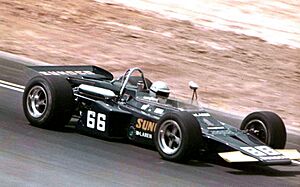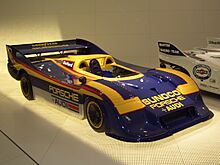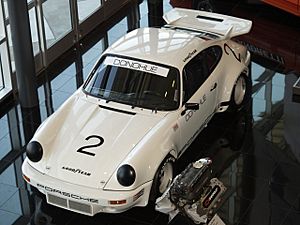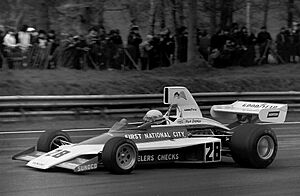Mark Donohue facts for kids
Quick facts for kids Mark Donohue |
|||||||
|---|---|---|---|---|---|---|---|
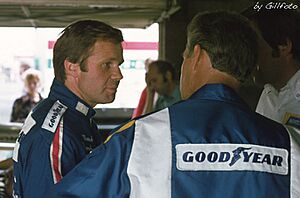
Donohue at the 1975 British Grand Prix
|
|||||||
| Born | Mark Neary Donohue Jr. March 18, 1937 Haddon Township, New Jersey, U.S. |
||||||
| Died | August 19, 1975 (aged 38) Graz, Austria |
||||||
| Championship titles | |||||||
| SCCA/CASC Can-Am (1973) Major victories 24 Hours of Daytona (1969) Pocono 500 (1971) Indianapolis 500 (1972) |
|||||||
| Champ Car career | |||||||
| 29 races run over 6 years | |||||||
| Best finish | 5th (1972) | ||||||
| First race | 1968 Telegraph Trophy 200 (Mosport) | ||||||
| Last race | 1973 California 500 (Ontario) | ||||||
| First win | 1971 Pocono 500 (Pocono) | ||||||
| Last win | 1972 Indianapolis 500 (Indianapolis) | ||||||
|
|||||||
| Formula One World Championship career | |||||||
| Nationality | |||||||
| Active years | 1971, 1974–1975 | ||||||
| Teams | Penske-entered McLaren and March chassis, Penske | ||||||
| Entries | 16 (14 starts) | ||||||
| Championships | 0 | ||||||
| Wins | 0 | ||||||
| Podiums | 1 | ||||||
| Career points | 8 | ||||||
| Pole positions | 0 | ||||||
| Fastest laps | 0 | ||||||
| First entry | 1971 Canadian Grand Prix | ||||||
| Last entry | 1975 Austrian Grand Prix | ||||||
| NASCAR Cup Series career | |||||||
| 6 races run over 2 years | |||||||
| First race | 1972 Winston Western 500 (Riverside) | ||||||
| Last race | 1973 Atlanta 500 (Atlanta) | ||||||
| First win | 1973 Winston Western 500 (Riverside) | ||||||
|
|||||||
| 24 Hours of Le Mans career | |||||||
| Years | 1966–1967, 1971 | ||||||
| Teams | Holman-Moody, Shelby-Ford, NART-Penske | ||||||
| Best finish | 4th (1967) | ||||||
| Class wins | 0 | ||||||
Mark Neary Donohue Jr. (born March 18, 1937 – died August 19, 1975) was a famous American race car driver and engineer. People called him "Captain Nice" because he was so good at setting up his own race cars. Later, some nicknamed him "Dark Monohue." He was known for being able to make his cars perform perfectly and then drive them to victory.
Mark Donohue is perhaps best known for driving the incredibly powerful Porsche 917-30, which had over 1500 horsepower. This car was so dominant it was called the "Can-Am Killer." He also won the famous Indianapolis 500 race in 1972. Donohue raced many different types of cars during his career, including the AMC Javelin, Chevrolet Camaro, Ford GT40, Ferrari 512, Porsche 911, and Shelby Cobra.
Contents
Early Life and First Races
Mark Donohue was born in Haddon Township, New Jersey, and grew up in Summit. He went to the Pingry School and then to Brown University in Providence, Rhode Island. While studying mechanical engineering at Brown, Mark started racing his 1957 Chevrolet Corvette at age 22. He won his very first race, a hillclimb event in New Hampshire. He earned his engineering degree in 1959.
In 1961, Donohue won a national championship in an Elva Courier. An experienced driver named Walt Hansgen noticed Mark's talent and became his friend. Hansgen helped Donohue get a chance to race an MG MGB in a big endurance event in 1964, which Mark won. The next year, Hansgen arranged for Donohue to be his teammate, driving a Ferrari in the 12 Hours of Sebring race. Donohue also won two other championships that year in different car classes.
Joining Roger Penske's Team
In 1966, the Ford Motor Company heard about Mark Donohue's skills. They asked him to drive one of their Ford GT40 race cars in the 24 Hours of Le Mans endurance race. Mark's co-driver, Walt Hansgen, sadly passed away during testing for the race. Donohue then teamed up with Australian driver Paul Hawkins, but their race ended early due to a car problem. Earlier that year, Donohue had finished third at the 24 Hours of Daytona and second at the 12 Hours of Sebring.
At Hansgen's funeral, a team owner named Roger Penske talked to Donohue about joining his racing team. In his very first race for Penske, Mark had an accident that badly damaged the car. However, Penske still believed in him.
Donohue returned to Le Mans with Ford in 1967, driving a new Ford GT, the Mark IV. He co-drove with Bruce McLaren, another famous driver. Even though they sometimes disagreed on how to set up the car, they worked together to finish fourth in the tough endurance race.
Later in 1967, Donohue started driving Penske's new Lola T70 car in the United States Road Racing Championship. Mark was incredibly successful, winning six out of seven races that year. He continued to dominate the series in 1968, even with some mechanical issues.
Trans-Am Series Success
Mark Donohue started racing in the Trans-Am Series in 1967 with Roger Penske's Chevrolet Camaro. He won three races that year. In 1968, Donohue had an amazing season in Trans-Am. He won the 12 Hours of Sebring again with his teammate Craig Fisher. Overall, he won 10 out of 13 races, setting a record for the series.
Donohue was one of the best Trans-Am drivers of his time. If there had been a championship for drivers back then, he would have won three of them. He won with Camaros in 1968 and 1969, and then with an AMC Javelin in 1971, all for Roger Penske Racing.
Penske and Donohue were always looking for ways to make their cars faster. They found a clever, but controversial, method to make their Camaros lighter. They would dip parts of the car in an acid bath, which would remove tiny bits of metal. This made the car lighter and therefore quicker. In one race, their car was found to be much lighter than the rules allowed. Donohue's victory was almost taken away, but after discussions, it was allowed to stand. However, the rules were changed for the next season to weigh cars before races.
Even with the new rules, Penske and Donohue continued to use their lightweight cars. They would strategically place weights in the car to balance it perfectly. They even used a trick at the 1968 Sebring race: they made two cars look identical and sent the legal-weight car through inspection twice, with different numbers. Then they raced both cars, one of which was much lighter. They won their class and 10 out of 13 races that year.
In 1970, Mark Donohue joined the AMC team, driving the AMC Javelin. He won three races, helping AMC finish second in the Manufacturers' Championship. In 1971, Donohue won seven races, including the last six in a row, leading AMC to win their first-ever Manufacturers' Championship.
Indianapolis 500 Victories
In 1969, Mark Donohue and Roger Penske competed in their first Indianapolis 500. Donohue finished seventh and was named Rookie of the Year. He raced at Indianapolis every year after that, finishing second in 1970.
Donohue finally won the Indianapolis 500 in 1972, driving for Penske. He set a new speed record of over 162 miles per hour (about 260 km/h), which stood for 12 years. This was Roger Penske's first victory at the Indy 500, a very important moment for his team.
NASCAR Racing
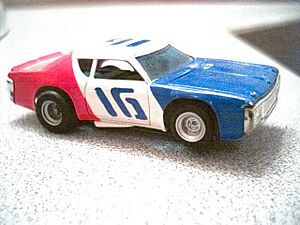
Donohue also raced in several NASCAR events. In the 1972–1973 season, he drove an AMC Matador for Penske Racing in NASCAR's top series, the Winston Cup. Donohue won the first race of the season at Riverside. This was Penske's first NASCAR win, marking the start of a long and successful history in NASCAR for the team.
The Powerful Can-Am Porsche
Between 1971 and 1972, Porsche asked Penske Racing and Mark Donohue to help develop the Porsche 917-10 car for the Can-Am series. During testing, Donohue suggested making the brake ducts larger for better cooling. The Porsche engineers agreed, but the new ducts caused the car's rear bodywork to fly off during a test run at high speed. The car crashed, and Donohue was left with his legs hanging out, still strapped in his seat. Amazingly, he only suffered a knee injury.
After his recovery, Porsche, Penske, and Donohue worked on the Porsche 917-30. This car had a new aerodynamic design and a powerful 5.4-liter turbocharged engine. The engine's power could be changed from about 1,100 to 1,500 horsepower with a knob in the cockpit! Donohue famously said the engine would "never have enough power until I can spin the wheels at the end of the straightaway in high gear."
On August 9, 1975, Donohue drove the 917-30 to set a world closed-course speed record at the Talladega Superspeedway in Alabama. He averaged 221.120 miles per hour (about 355.8 km/h). This record stood for 11 years.
The 917-30 was so dominant that it was nicknamed the "Can-Am killer." It won almost every race in the 1973 Can-Am championship. However, after the Arab Oil Embargo in 1973, new fuel limits were put on racing, which made the powerful 917/30 less competitive. Today, the 917/30 is considered one of the most powerful and successful racing machines ever made.
First IROC Champion
Mark Donohue competed in the very first IROC series in 1973–74. In this series, all drivers raced identical Porsche RSR cars. Donohue won three of the four races, including the final race at Daytona. By winning the first IROC championship, he proved he was one of the best drivers of his time, beating other legends like Richard Petty and A. J. Foyt.
Retirement and Formula One
The intense pressure of both racing and designing cars started to affect Donohue. By 1973, his "Captain Nice" nickname began to change to "Dark Monohue." He announced he would retire from racing after the 1973 Can-Am season. Also, a tragic accident at the 1973 Indianapolis 500 that led to the death of his friend, Swede Savage, pushed him to quit.
However, his retirement didn't last long. Roger Penske convinced him to return to racing full-time to join his new Formula One team, Penske Cars Ltd. Donohue had already raced in Formula One once before, in 1971, where he finished third at the 1971 Canadian Grand Prix. He returned to Formula One for the last two races of the 1974 season and planned a full season for 1975.
The 1975 Formula One season was tough for Donohue and Penske. Mark managed to finish fifth in two races, but their new Penske PC1 car had many problems. For the Austrian Grand Prix, Penske decided to switch to a different car, the March 751.
Tragic Death
Just a few days after setting a speed record at Talladega, Mark Donohue arrived in Austria for the 1975 Austrian Grand Prix. During a practice session, a tire on his March car failed. He lost control and crashed into the safety fence. A track worker was sadly killed by flying debris, but Donohue seemed mostly unharmed. However, he soon developed a headache that got worse. The next day, after going to the hospital, Donohue fell into a coma due to bleeding in his brain and passed away. He was survived by his second wife and two sons. Mark Donohue is buried in Summit, New Jersey.
After his death, the corner where the accident happened was made safer. In 1986, Donohue's family settled a lawsuit against Penske and Goodyear, claiming a tire failure caused the crash.
Remembering Mark Donohue
Mark Donohue's legacy lives on in many ways.
- In 2003, to celebrate Penske Racing's 50th NASCAR win, driver Ryan Newman drove a car painted to look like Donohue's 1973 AMC car.
- Penske Racing's main building in North Carolina has murals of Donohue and his famous race cars.
- Donohue wrote a book about his racing career called The Unfair Advantage. It explains his engineering approach to making cars faster and how he learned from his experiences. The book was published shortly before he died.
- Mark's son, David Donohue, has also become a successful race car driver.
Awards and Honors
- In 1973, Drexel University gave Mark Donohue their Engineering and Science Award.
- He was inducted into the International Motorsports Hall of Fame in 1990.
- He was also inducted into the Motorsports Hall of Fame of America in 1990.
- In 2006, he was inducted into the Sports Car Club of America Hall of Fame.
Images for kids
See also
 In Spanish: Mark Donohue para niños
In Spanish: Mark Donohue para niños


